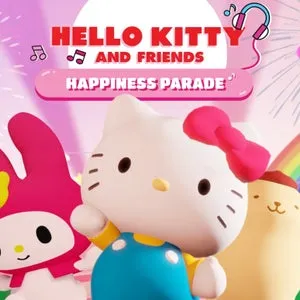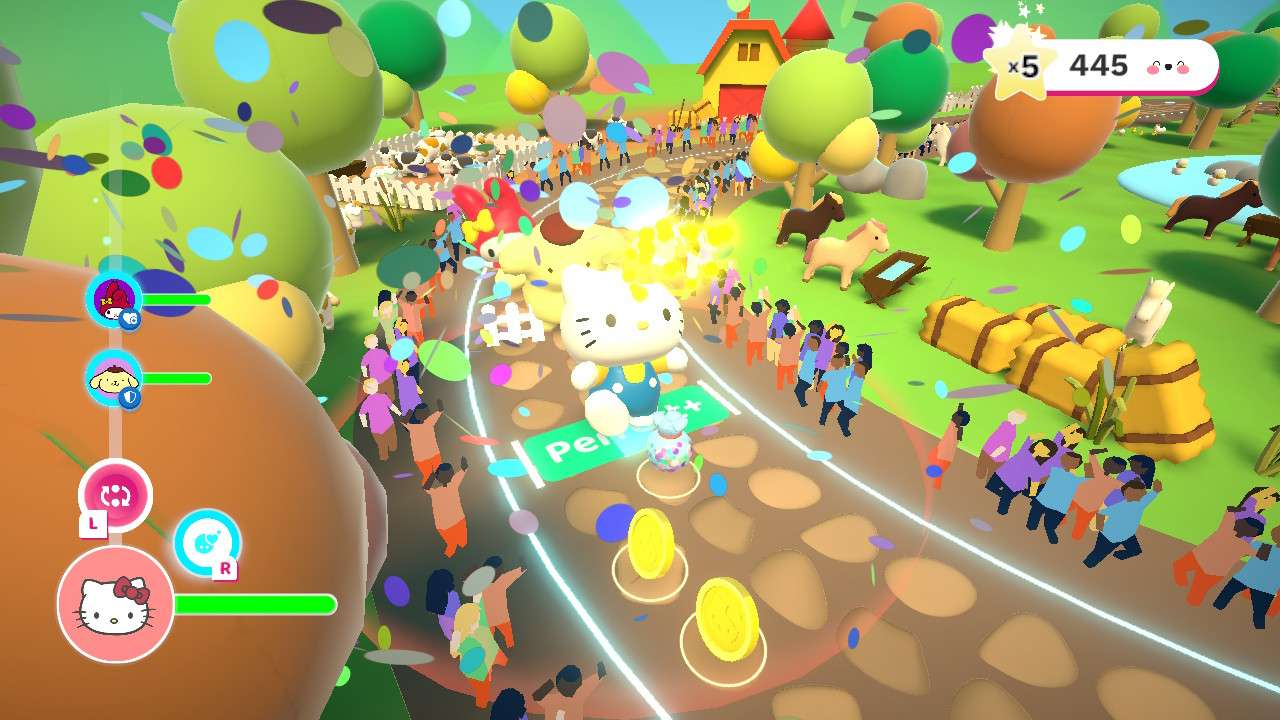Search
[{{{type}}}] {{{reason}}}
{{/data.error.root_cause}}{{{_source.title}}} {{#_source.showPrice}} {{{_source.displayPrice}}} {{/_source.showPrice}}
{{#_source.showLink}} {{/_source.showLink}} {{#_source.showDate}}{{{_source.displayDate}}}
{{/_source.showDate}}{{{_source.description}}}
{{#_source.additionalInfo}}{{#_source.additionalFields}} {{#title}} {{{label}}}: {{{title}}} {{/title}} {{/_source.additionalFields}}
{{/_source.additionalInfo}}Hello Kitty and Friends: Happiness Parade (Switch)

Hello Kitty and Friends: Happiness Parade
Developed By: Dabadu Games
Published By: Rogue Games
Released: October 26, 2023
Available On: Nintendo Switch, Mobile
Genre: Music
ESRB Rating: Everyone
Number of Players: 1 offline
Price: $19.99
Thank you Rogue Games for sending us a review code!
“Hello Kitty musical roguelike” was probably not on anyone’s gaming wishlist this year, but Dabadu Games and Rogue Games have made the impossible possible. Originally released on mobile devices through Netflix, Hello Kitty and Friends: Happiness Parade is a surprisingly tough music game with roguelike elements.
As the name suggests, Hello Kitty and Friends: Happiness Parade is all about Hello Kitty and her friends spreading happiness with a parade. Kuromi, the resident baddie in the group, wants to foil their plans, so she constructs traps and robots to impede the group. It’s up to you to traverse the world map and make sure the parade is a success!
Each stage has you control three (or more as you unlock more slots) of the Hello Kitty gang as you march to the beat of the song. There are three lanes, and you’ll need to switch constantly since there are obstacles in the way. In a manner similar to Crypt of the Necrodancer, each step is synced to a button press. If you are unsuccessful in your rhythm timing, you won’t be able to do your action (whether it be switching lanes, activating character powers, or changing the active character). Robots will also try and impede your progress by laying down projectiles, while things like swinging hammers can destroy your team if you aren’t careful.
In the middle of stages, there are photoshoot opportunities, where if you have the correct active character, you can time L and R button presses to earn bonus points. The Switch version of the game also allows the use of Joy-Con movement so you can wave your controllers to conduct your party to move around. It’s a novel addition, but I just stuck to button presses since they were more reliable.
To help you out in the game, each member has a special power: From Hello Kitty’s ability to befriend robots to Tuxedo Sam’s ability to reduce the cooldown on abilities, each character has a specialty that will work for any playstyle during your run. Most of the popular Sanrio characters are present, so if you wanted a My Melody/Kiki/Badtz Maru team-up… you’ve got it!

Strong Points: Great music; surprisingly challenging roguelike gameplay
Weak Points: Restricted play modes; some replay value feels like padding; slightly unfair obstacles
Moral Warnings: Mild cartoon violence; lyrics in one song references alcohol
Speaking of runs, the game is structured like a roguelike. When you begin, you’ll pick your starting team and pick which stages you want to play. While the music can be easily shuffled, the difficulty of the overall game is up to you. There are five different end stages with specific music that you can tackle, with new characters and songs being unlocked as you play.
However, health and progress are saved during your run, and should you lose all your characters, your run is over, and you need to start over again. However, as you continue to play, you’ll earn cards to level up your characters (so you can upgrade for shorter ability cooldowns and more potent powerups). Overall progress is saved between runs, and there’s an total progression bar as well; filling this up will allow you to add more characters to your starting lineup, as well as unlock cute cosmetics for your party. You’ll unlock music and characters when you go through your run route, but some characters have multiple point locks (where you must achieve a specific stage score to break a lock). This means you’ll need to play through the same stage multiple times, which sometimes feels like padding. While I did enjoy getting new characters and trying to figure out my optimal route for getting more content, I think the unlock system should favor one-time encounters rather than forcing players to grind.
Speaking of which, it’s a shame that you’re only offered the main mode to play the game. This means if you wanted to do a free play to practice, you’ll need to play the main mode to do so. There’s also no way to pick your song before you start a stage (you can shuffle songs to get what you want, but it’s more cumbersome than picking your song choice).
These game design decisions are baffling, and I think adding some more modes with a casual practice component would be good for this title. Additionally, the game’s deceptively difficult, in that many might expect a Hello Kitty game aimed at children to be easy. It’s not, especially if you try going to the final Kuromi route early on in your quest. Games that have higher difficulties for all ages isn’t necessarily a bad thing, but the learning curve is steep for those that aren’t used to roguelikes or rhythm games. There’s an autodance mode (where all you need to do is control your party without the rhythm aspect), but with obstacles taking out most or all of your health at once, it’s unforgiving for newer players. However, for those that thrive with these games, you’ll love the main gameplay loop, which offers hours of roguelike-rhythm fun.

Higher is better
(10/10 is perfect)
Game Score - 80%
Gameplay – 15/20
Graphics – 8/10
Sound – 8/10
Stability – 5/5
Controls – 4/5
Morality Score - 93%
Violence – 8.5/10
Language – 10/10
Sexual Content – 10/10
Occult/Supernatural – 10/10
Cultural/Moral/Ethical – 8/10
In terms of presentation, the game looks visually adorable. The whole Sanrio franchise is based on cuteness, and honestly this is no exception. Hello Kitty and Friends: Happiness Parade looks great docked or undocked. Performance was solid, as I didn’t experience any slowdown, and the game was stable during my playthrough.
The soundtrack is a highlight for the game and features a ton of different genres. From pop to EDM to Japanese tracks, the songlist complements the cutesy vibe the game has going for it. This version of the game features a few more songs compared to the mobile versions, so even if you played the original Netflix mobile version, you can double dip here. Even though the licensed music here is from independent artists, Hello Kitty and Friends: Happiness Parade does a great job enticing me with its soundtrack. Each song fits the game’s cheery atmosphere very well. The sound design, on the other hand, leaves a lot to be desired. The characters are silent, which is fine, but I could have used an announcer or some other appropriate sound effects. There are a few for collisions and powerups, but sometimes it feels hollow. Again, the soundtrack more than makes up for this.
In terms of objectionable content, while there aren’t any songs with explicit language present, one song, “Pop Beer Sausage” frequently mentions alcohol. The translated lyrics also reference getting drunk as well. (However, said song is in Japanese, so only the word “beer” is said in English). In addition, the game features the characters getting hurt through mild cartoon violence, though nothing gory is shown. If a character loses all his or her health, he or she will disappear immediately (though it’s not implied that the character has died).
While it’s a surprising mix that might not appeal to everyone (and may alienate some of its target audience), Hello Kitty and Friends: Happiness Parade is a solid rhythm game. Its cartoony graphics hide a surprisingly challenging experience.




